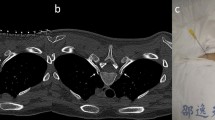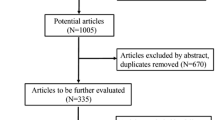Abstract
Objective
Ablation of the upper thoracic sympathetic ganglia that innervates the hands is the most effective and permanent cure of palmar hyperhidrosis. However, this type of sympathectomy causes irreversible neural damage and may result in severe compensatory hyperhidrosis. This experiment is designed to confirm the hypothesis, in which the stimulation of T2 sympathetic chain leads to increased palmar microcirculation, and thus results in treating hyperhidrosis.
Methods
In this study, we used electric stimulation to induce reversible blockade of the sympathetic ganglion in pigs and investigated its effect on palmar perfusion. An electrode was inserted to the T2 sympathetic ganglion of the pig through three different approaches: open dorsal, thoracoscopic, and fluoroscopy-guided approaches. Electric stimulation was delivered through the electrode using clinically available pulse generators. Palmar microcirculation was evaluated by laser speckle contrast imaging.
Results
The T2 sympathetic ganglion of the pig was successfully accessed by all the three approaches, as confirmed by changes in palmar microcirculation during electric stimulation. Similar effects were not observed when the electrode was placed on the T4 sympathetic ganglion or off the sympathetic trunk.
Conclusion
We established a large animal model to verify the effect of thoracic sympathetic stimulation. Electric stimulation can be used for sympathetic blockade, as confirmed by increased blood perfusion of the palm. Our work suggests that sympathetic stimulation is a potential solution for palmar hyperhidrosis.




Similar content being viewed by others
References
Gossot D, Galetta D, Pascal A, Debrosse D, Caliandro R, Girard P, et al. Long-term results of endoscopic thoracic sympathectomy for upper limb hyperhidrosis. Ann Thorac Surg. 2003;75(4):1075–9.
Kopelman D, Assalia A, Ehrenreich M, Ben-Amnon Y, Bahous H, Hashmonai M. The effect of upper dorsal thoracoscopic sympathectomy on the total amount of body perspiration. Surg Today. 2000;30(12):1089–92.
Lin CC, Mo LR, Lee LS, Ng SM, Hwang MH. Thoracoscopic T2-sympathetic block by clipping—a better and reversible operation for treatment of hyperhidrosis palmaris: experience with 326 cases. Eur J Surg. 1998;164:13–6.
Loscertales J, Congregado M, Jimenez-Merchan R, Gallardo G, Trivino A, Moreno S, et al. Sympathetic chain clipping for hyperhidrosis is not a reversible procedure. Surg Endosc. 2012;26(5):1258–63.
Miller DL, Force SD. Temporary thoracoscopic sympathetic block for hyperhidrosis. Ann Thorac Surg. 2008;85(4):1211–4 (discussion 1215).
Munglani R. The longer term effect of pulsed radiofrequency for neuropathic pain. Pain. 1999;80(1–2):437–9.
Kim ED, Yoo WJ, Kim YN, Park HJ. Ultrasound-guided pulsed radiofrequency treatment of the cervical sympathetic chain for complex regional pain syndrome: a retrospective observational study. Med (Baltim). 2017;96(1): e5856.
Lee JY, Sim WS, Kang RA, Lee EK, Yang JY, Kim DY. Lumbar sympathetic pulsed radiofrequency treatment for primary erythromelalgia: a case report. Pediatr Dermatol. 2017;34(1):e47-50.
Lin ML, Huang TR, Kao MC, Chiu HW, Lin SC, Chang FC. Pulsed radiofrequency stimulation suppresses palmar hyperhidrosis in an animal study. Brain Behav. 2017;7(11): e00833.
Yamamoto H, Okada M. Application of laser speckle flow graph for compensatory sweating. J Thorac Cardiovasc Surg. 2017;154(6):e113–5.
Yang SH, Tsai JC, Kao MC. Laser Doppler scanning study of palmar skin perfusion for patients with hyperhidrosis before and after thoracic sympathectomy. Surg Neurol. 2006;66(Suppl 2):S48–51.
Ng I, Yeo TT. Palmar hyperhidrosis: intraoperative monitoring with laser Doppler blood flow as a guide for success after endoscopic thoracic sympathectomy. Neurosurgery. 2003;52(1):127–31.
Pillay PK, Awad IA, Dohn DF. Upper thoracic sympathectomy by a posterior midline approach. Neurosurgical Operative Atlas. Park Ridge, IL: Williams & Wilkins, 1991. p. 267–73.
Wilkinson HA. Percutaneous radiofrequency upper thoracic sympathectomy. Neurosurgery. 1996;38(4):715–25.
Turner BG, Gee DW, Cizginer S, Konuk Y, Karaca C, Willingham F, et al. Feasibility of endoscopic transesophageal thoracic sympathectomy (with video). Gastrointest Endosc. 2010;71(1):171–5.
Zhang J, Zhu L, Yang S, Chen L, Li D, Zheng H, et al. Feasibility of endoscopic transumbilical thoracic sympathectomy in a porcine model. Interact Cardiovasc Thorac Surg. 2013;17(1):127–31.
Ebert TJ, Muzi M, Berens R, Goff D, Kampine JP. Sympathetic responses to induction of anesthesia in humans with propofol or etomidate. Anesthesiology. 1992;76(5):725–33.
Liu X, Rabin PL, Yuan Y, Kumar A, Vasallo P 3rd, Wong J, et al. Effects of anesthetic and sedative agents on sympathetic nerve activity. Heart Rhythm. 2019;16(12):1875–82.
Schick CH, Fronek K, Held A, Birklein F, Hohenberger W, Schmelz M. Differential effects of surgical sympathetic block on sudomotor and vasoconstrictor function. Neurology. 2003;60(11):1770–6.
Funding
This work was supported by grant FY107-38 from the National Taiwan University Hospital and the Industrial Technology Research Institute cooperation research project. This work was also supported by the Taiwan Ministry of Science and Technology (Grants 109-2634-F-002-029 and 110-2314-B-002-161).
Author information
Authors and Affiliations
Corresponding author
Additional information
Publisher's Note
Springer Nature remains neutral with regard to jurisdictional claims in published maps and institutional affiliations.
Rights and permissions
About this article
Cite this article
Liao, HC., Su, F.T., Chen, TH. et al. Effects of thoracic sympathetic stimulation on palmar perfusion: a preliminary study in pigs. Gen Thorac Cardiovasc Surg 70, 153–159 (2022). https://doi.org/10.1007/s11748-021-01698-y
Received:
Accepted:
Published:
Issue Date:
DOI: https://doi.org/10.1007/s11748-021-01698-y




